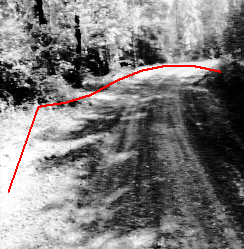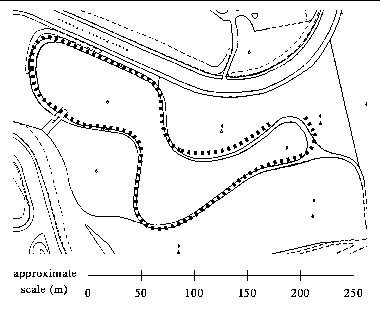
In order to be able to successfully navigate autonomously, a vehicle needs to have an understanding of the local world. It must understand where it is safe to drive and be able to recognize static and moving objects. It must also be able to relate this understanding to the desired route plan, so that progress may be made in the most sensible way. This project attempts to bridge the large gap between making sparse three dimensional measurements of scene structure and achieving a useful level of understanding of that structure. In particular, it addresses the need to know where in the scene it is safe to drive, and where static obstacles lie.
The real time image processing system which provides the three dimensional scene information for this research is ``live DROID'', developed at Roke Manor Research Limited and DRA Chertsey. DROID provides a list of three dimensional scene measurements, made at well localized places in the image, as the camera is moved through the environment. DROID also produces an estimate of the camera's own motion in the world, given only an initial space scaling factor (enabling the resolution of the scale/speed ambiguity). It works by tracking two dimensional features over time, using a Kalman filter for the three dimensional tracking of each point. (See a very brief introduction to DROID here.)
This project (ALTRUISM) is attempting to increase the intelligence (and therefore complexity) of the interpretation of the 3D data supplied by DROID. DROID-ALTRUISM has been implemented as a real-time system on PowerPC/Transputer image processing equipment.
ALTRUISM starts by finding a recursive least squares fit of a planar-quadratic ``ribbon'' to the three dimensional tracked features, ignoring upper outliers. This gives an estimate of the three dimensional ``road'' parameters. These four parameters are temporally filtered. Those three dimensional features (tracked by DROID) which lie ``on'' the computed driveable surface are distinguished from those which do not. Here is an example segmentation, where the vehicle is travelling along a rough track;

This information is used to compute a radial map of the limits of the driveable surface in the central-tangential plane of that surface. The resulting list of distances may extend further than objects which lie on it but are not perceived as forming its boundary. The radial map is filtered within each new estimation to reduce noise and to interpolate missing data, and also filtered temporally. Reprojecting this map into the image gives;

Showing this map from plan view, gives this figure. Also shown is the estimated steering direction command, which will soon be used to control the steering of the vehicle.
Finally, the computed planar-quadratic ground surface is used to provide a measure of scale drift within DROID, a serious problem over large sequences unless camera calibration is completely perfect. The estimated height of the camera above the ground, assumed to be constant in reality, is used to drive a feedback loop to force this height measurement to stay constant.
The video sequence from which the above examples were taken lasts seven minutes. The following figure shows the estimate by DROID-ALTRUISM of the route taken by the camera (the dotted line), superimposed on a map of reality;
 (Press to get full size image.)
(Press to get full size image.)
A paper on this work has been published in EAAI; for the original report, either download the PostScript (altruism.ps.gz - 330 K / altruism.ps - 1.5 Megs) or view the html.